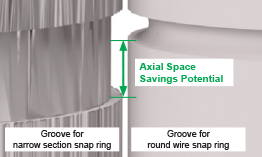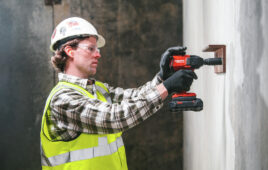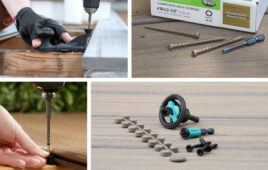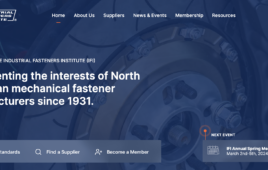Written by Jürgen Wenzel
Director of Global Marketing, Rotor Clip

The original piston rod to piston head coupling design.
Manufacturers today face many challenges when building machines and equipment that are supposed to run as smoothly as possible to be efficient, safe, and long-lasting. Design engineers are constantly pushing the limits of feasible designs to maintain an edge in the race for higher efficiency and durability.
This was also the case for the manufacturer of this coupling assembly where a rod is connected with a piston head. Piston rod/piston head assemblies are typically seen in applications like hydraulic cylinders, brakes, pumps, and compressors.
In this specific example, the assembly requires frequent disassembly and reassembly for maintenance purposes. Therefore, the head needs to be easily removed and installed, yet always maintain a secure connection to ensure the safe and effective operation of the application.
The manufacturer of this assembly approached Rotor Clip to find a solution that would allow for a more secure and precise connection of piston and head, while maintaining ease of assembly, provide space savings, and reduce overall cost.
Rotor Clip’s application engineers welcomed the challenge and investigated the current design to come up with a solution that would meet all of the old and new application requirements.
The original design uses a narrow section snap ring to couple the piston with the piston head. A shallow, but wide groove holds the ring in place at the end of the piston, where the piston head is then pushed over the ring onto the piston. The ring applies a radial force on the inner wall of the piston head, coupling it to the main piston shaft while still allowing for easy disassembly.
Narrow section snap rings are suitable solutions in instances where the radial wall thickness of the piston and the opposite piston head are limited, as this type of snap ring only requires a shallow groove. However, there are multiple disadvantages to a coupling assembly utilizing a narrow section snap ring in this fashion. One drawback of such a design is the degree of retention force offered by this type of ring. Due to its narrow section, this type of ring can only exert a very limited radial spring force against the inner wall of the piston head. It is this force alone that creates friction, which holds both components together.
Over time, the wear on ring and housing caused by repeated disassembly, together with a diminishing spring force can lead to loose coupling, resulting in diminished application performance; shortened application life, and ultimate failure of the application.
The second disadvantage of this design is that it allows for too much assembly variance. By only using the friction of the ring against the housing wall of the piston head, no set distance between the piston rod and head in the axial direction can be established. The piston head can be positioned anywhere between the very top of the piston to fully seated on the piston. These deviations in the piston head position lead to variations in the compression ratio of the assembly, which affects the application performance.
The third drawback is the ring’s axial space requirement. Even though narrow section snap rings only need a shallow groove to function, they require a very wide groove, which in many cases is more than double when compared to traditional snap rings. This requires the mating components to be long enough in the axial direction to accommodate the groove, resulting in an increased assembly size and weight.
Rotor Clip’s application engineers found a simple solution to upgrade the old coupling design and give the manufacturer all the requested application improvements while maintaining its pre-existing benefits.
The new and improved design utilizes a round wire snap ring seated in two grooves to connect the piston and piston head. The first groove is located on the piston rod and the second groove is located on the inside of the piston head housing. When the ring is installed in both grooves it effectively creates an ID/OD lock, coupling both components securely together.
The improved design solves for all application requirements that the manufacturer had requested in the following ways.

Round wire snap rings offer a great balance between retention force and radial clearance once installed into a groove.
More secure connection, while maintaining an easy assembly. The retention force of the round wire snap ring, which holds the piston and piston head together, can be precisely tailored to the exact needs of the application. By modifying the groove depths and selecting a specific ring wire size, application engineers can precisely tailor the force needed to connect and disconnect the piston head from the piston rod; securely connecting the two parts while also allowing for easy assembly and disassembly of the application.
More precise connection. The ID/OD lock created by the ring and the 2 grooves eliminates the variable installation distance between the piston rod and the piston head, making for a precise and repeatable assembly process during maintenance of the application. The grooves in the piston and piston head are precisely located in a way that when the ring is seated in both, piston and piston head are positioned for optimum application performance.
Space savings and overall cost reductions. Round wire snap rings operate in much narrower grooves than narrow section snap rings and therefore require less axial space to function properly. This allowed for a reduction in total assembly height. The end result is a more compact and lighter application that is, ultimately, less costly to produce.
Another cost savings benefit comes from the production method of the round wire snap ring itself. When compared to narrow section snap rings, round wire snap rings are more economical to produce and less cost-intensive, which equates to cost savings for the end-user.

The space-saving potential and groove width comparison between a narrow
section snap ring and a round wire snap ring design.
As this example demonstrates, small changes in application design can bring many performance and cost advantages. It is therefore important that manufacturers and design engineers partner with suppliers that have experience in design optimization and a large portfolio of product solutions at their disposal. The parameters of your application determine which ring, spring, or clamp is best suited for your application.
Operating conditions, installation requirements, anticipated loads, space constraints, and axial end-play are all factors to consider when selecting the right part.














Tell Us What You Think!